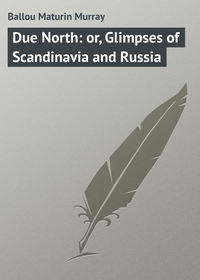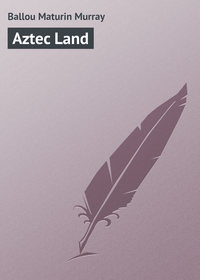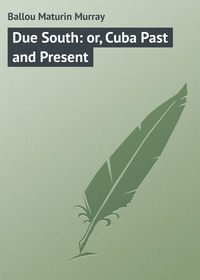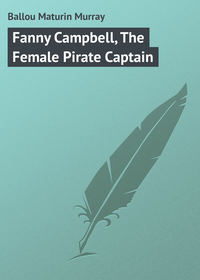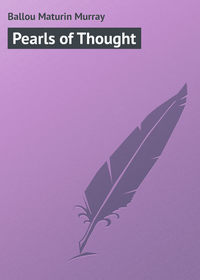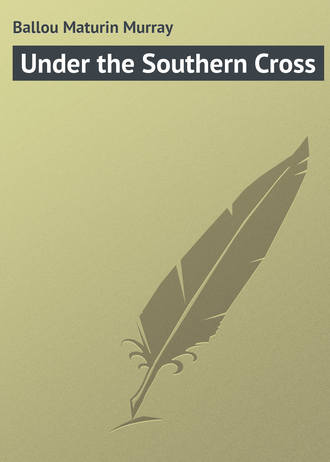 полная версия
полная версияUnder the Southern Cross
We made the island of Oahu, passing along the windward shores of Maui and Molokai in the early gray of a soft June morning, and doubling the lofty promontory known as Diamond Head, which rears its precipitous front seven hundred feet above the sea. We ran along the coast while the sun rose and beautified the mountain-tops, the green slopes, gulches, and fern-clad hills sparkling with streamlets. The dawn was lovely in its aspect, fresh and sweet. A gentle land-breeze brought us the dewy fragrance of the flowers which had been distilled from a wilderness of bloom during the tropical night. The uncertain light melted slowly away as a dainty flush appeared in the east. A few transparent clouds hung over the verdant isle, clouds so fleecy and ermine-like that they might have been the mantles of angels. It was entrancing thus to be gliding noiselessly over a perfectly calm sea, with so many attendant elements of beauty. We stood quite alone in the bow of the ship, wondering how the passengers below could court the thrall of sleep at such a moment.
As we drew nearer and nearer to the shore, sugar plantations, cocoanut groves, and verdant pastures came clearly into view, dotted here and there with the low primitive dwellings of the natives, and occasionally ornamented by the picturesque, vine-covered cottages of American and European residents. As the city of Honolulu was approached, it seemed to be half buried in a cloud of luxuriant foliage. Blessed with frequent rains, drought is not known here, and the verdure is perennial.
The sudden change of the color of the ocean was very noticeable as we steamed at half speed through a narrow gap of the coral reef which forms a natural breakwater to the harbor. We passed the light-house which stands on the inner edge of the reef, – a structure not over thirty feet in height, consequently not visible from a ship's deck more than ten miles away. The captain informed us that it was the only light between this island and the coast of New Zealand, in the far South Pacific. The channel through the reef to safe anchorage is carefully buoyed on either side, and at night a safety-lantern is placed upon each of these little floating beacons, so that a steamer can easily steer her course in safety, come when she may.
Though the volcanic origin of the land is plain, it is not the sole cause of these reefs and islands appearing thus in mid-ocean. Upon the flanks of the upheaval the coral insect with tireless industry rears its amazing structure, until it reaches the surface of the waves as a reef, more or less contiguous to the shore, and to which ages finally serve to join it. The tiny creature delegated by Providence to build these reefs dies on exposure to air, – its work being then done. The far-reaching antiquity of the islands is established by these very coralline formations, which could only have attained their present elevation just below the surface by the growth of thousands of years. As already intimated, the land rises so abruptly from the bottom of the sea that the water retains its dark-blue tint to within a short distance of the shore, where it assumes a light-blue and bottle-green hue, with other magic colors striking in their effect viewed beneath the clear morning light and embossed with the rays of the glowing sun.
We were soon safely moored inside the harbor, where there is an average depth of sixteen fathoms, and room for a hundred large vessels to find anchorage at the same time. The wharves are spacious and most substantially built, with ample depth alongside. Honolulu, which is situated on the south side of the island, is the commercial port of the whole group, – the half-way house, as it were, between North America and Asia, California and the New World of Australasia.
The streets of the Anglo-Hawaiian capital are clean and all admirably macadamized, the material employed for the purpose being coral, black lava, stone, and sand. At night the thoroughfares are rendered nearly as light as by day, through the liberal use of gas. One of the first things to attract our attention after landing was a huge steam-rolling machine at work upon the road-bed of one of the streets leading to the wharves. The city, with its twenty thousand inhabitants more or less, has all the belongings of modern civilization, such as churches, charitable institutions, hospitals, schools, gas, electric lights, and the telephone; yet it was forced upon the mind how brief the period that had transpired since this was nearly a wilderness, peopled by a race of cannibals, whose idolatrous superstitions involved frequent human sacrifices. To-day nearly all the rising generation can read and write, and the entire race are professed Christians. One fact especially indicative of progress came to our knowledge; namely, that the government expends fifty thousand dollars annually upon the local schools. Could a stronger contrast be found than the aspect presented by Honolulu when Captain Cook discovered these islands, in 1778, and that of the Honolulu of 1888? In imagination we find ourself trying to look forward to the close of another century, and surmising what may then be the condition of these isolated spots of earth.
The original paganism of this people was of the most brutal type, revelling in human gore. We were told of rows of stone altars on which a hundred victims are known to have been sacrificed at one time, the altars still standing as memorials of the wretched idolatrous worship of the past. Such scenes were of frequent occurrence among the aborigines, surrounded by a climate which was nearly perfect, and by a profuseness and bounty of vegetation that made the support of life a mere holiday existence. They poured out human blood like water upon the altars erected to their idols, and fattened upon human flesh. It is strange indeed that some of the most lovely parts of the world should have been peopled by cannibals. We speak in the past tense; but all travellers in savage, half-civilized lands know that there are many waste places of the earth which are to-day the abode of the anthropophagi.
In those early days the several islands of the Hawaiian group had each a separate king. Bitter wars were frequent among them, and the savages of the Pacific islands always ate their prisoners taken in battle. King Kamehameha finally subjected the several isles to his sway, and founded the government which has lasted to our day.
Many of the streets of Honolulu present a grateful shade along the sidewalks, being lined by choice ornamental trees, of which the cocoanut, palm, bread-fruit, candle-nut, and some others are indigenous; but many have been introduced from abroad and become thoroughly domesticated. The tall mango-tree with its rich, glossy leaves, the branches bending under the weight of its delicious fruit, was seen growing everywhere, though it is not a native of these islands. It was impossible not to observe with acute interest the great variety of fruit-trees, most of whose pendulous branches were heavy with luscious products. Among them were the feathery tamarind, the orange, lime, alligator-pear, citron-fig, date, palm, rose-apple, and some others whose names we did not learn. Of all the flowering trees the brilliant Ponciana regia was most conspicuous and attractive, with its cloud of scarlet blossoms, each cluster as large as a Florida orange.
Some of the thoroughfares, especially that known as King's Street, are lined by pretty, low-built cottages, standing a hundred feet and more back from the roadway, with broad, inviting verandas, the whole front festooned and nearly hidden by tropical and semi-tropical plants in full bloom. This delightful aspect was supplemented by lovely flower-beds, and groups of ornamental trees in the gardens, with here and there an isolated Norfolk Island pine, forcing its strong individuality of shape and foliage upon the observation. A China rose-tree full of crimson flowers was noticed, and in a garden near the palace we saw a peach-tree, with one side full of rosy blossoms, while the other was decked with ripening fruit. How this was achieved we did not stop to inquire, pausing only long enough to admire the novel and anomalous effect. The gardens of Honolulu do not lack for water, a never-failing supply of the precious liquid being brought from the neighboring mountains in large iron pipes, and introduced into each city dwelling; moreover, we were told by the residents that they have only to sink a well ten or twelve feet deep anywhere on the plateau occupied by the city, when an abundance of water can always be secured. It was delightful to think that this lovely floral display to be seen all about us, around the native shanties as well as in the grounds of the better classes, was not confined to any one season, but that the various months of the year were severally beautified with roses, lilies, and the thousand and one gems of Flora's kingdom grown out-of-doors.
The race-course of Honolulu is situated four or five miles from the city proper, and is reached by a hard, well-kept, level road passing, it seemed, through one continuous tropical garden. Here was presented to us a gay and interesting picture of strong local color. The course occupies ample grounds laid out and fenced in the usual circular style of a one-mile track. The racing was conducted by the Jockey Club of the city, who certainly introduced on this occasion some remarkably well-bred animals. However they may have become possessed of the money, the natives, high and low, seemed to have plenty of loose cash to bet with, and the silver dollars were rapidly passed from hand to hand as each trial came to an issue. It was all conducted upon the cash principle; no accounts seemed to be kept, but settlements were made then and there, between the races. The scene was enlivened with music furnished by the king's native band, composed of twenty-eight colored men led by a German conductor. This band is certainly under remarkable discipline and very scientific instruction, and few similar organizations of white men in America can be truthfully said to excel them. They were uniformed in pure white linen ornamented with brass buttons, bearing the national Hawaiian arms, and wore snow-white helmets tipped with spikes of glittering brass of the German army pattern.
King Kalakana, who is very fond of racing and always assists at these exhibitions, greeted us cordially upon the grand stand, where he sat among the other spectators dressed in a suit of white linen and a plain straw hat. A few moments later, by invitation of his Majesty we stepped into an adjoining apartment, where he jauntily tossed off a goblet brimming with champagne, adding a few pleasant words of welcome. The trouble with him is that he is far too much inclined "to look upon the wine when it is red," though we were informed confidentially that his favorite tipple was gin. Notwithstanding that he is a man of more than ordinary intelligence, and even of a considerable degree of culture, morally speaking he has no traits of character which command respect, and is at times so much given to a sensual life as to outrage all kingly associations, incurring the disgust even of his most intimate associates. In person he is tall, well built, a little over six feet in height, of very dark complexion, and with crisp curly hair. He is remarkably superstitious, we were told, and consults pretended supernatural agents as to various State matters. This trait must have been born in him, and is matched by a similar spirit prevailing in the breast of every native. He is too selfish in disposition to be exercised by any real degree of patriotism, and "can be bought at a very low market value in connection with any private enterprise," to quote the words of a leading citizen with whom we conversed about the political condition of the islands. There are always plenty of adventurers ready to take advantage of such possible venality, and our informant told us that there were stories privately circulated, and undoubtedly true, which if publicly substantiated would result in his being dethroned. "Indeed," he added, "there is only a sort of phantom royalty maintained in Honolulu." These considerations did not tend to prepossess us much in the king's favor; and besides, it was impossible readily to forget that his direct ancestors slew, roasted, and ate Captain Cook.
This delectable monarch has just passed his fifty-second year, and as he may very properly be styled a fast liver, his career will hardly be a long one, more especially as the islands seem to be in a troubled political condition, so deep seated that a revolution is at all times imminent, while the proposed establishment of a republic is freely prognosticated and openly discussed. It is reported that the king has lately been detected in receiving heavy bribes for the granting of certain valuable and exclusive privileges; besides which, his personal life and habits being, as already intimated, extremely repulsive to a large portion of the people, he is growing daily more and more unpopular. It is well known that merchants and resident foreigners have been for some time taking serious steps for self-protection and the safe care of their property in the event of a popular uprising. The present king, it will be remembered, was elected to the throne by ballot upon the death of the former sovereign, who died about fourteen years ago, without leaving any regular heir to succeed him. The heir-apparent to the throne is the brother of the king, and is now thirty-three years of age.
CHAPTER II
Ladies Riding Astride. – Passion for Flower Decorations. – A Sailor on a Bucking Horse. – A Weekly Gala-day. – Hawaiian Ladies' Costume. – A Famous Battle-ground. – The Native's Staff of Life. – Ubiquitous John Chinaman. – Largest Apple-orchard in the World. – Hawaiians as Cannibals. – An Active Volcano. – Colony of Lepers. – Unwelcome Visitors. – Our Political Relations with the Sandwich Islands.
There are not infrequently substantial reasons for customs which appear to us absurd at first blush. It was observed at the race-course of Honolulu that the women all rode man-fashion, – that is, astride of their horses; and being accustomed to the saddle from childhood they rode remarkably well. Even European and American ladies who become residents also adopt this fashion of riding, for the reason, as we were told, that side-saddles are not considered to be safe on the steep mountain roads. If one rides in any direction here mountains must be crossed. Every one rides on horseback, – men, women, and children. He must be a poor man indeed who does not own two or three horses of the pony, island breed. There are plenty of light American-built vehicles to be had for use about the city roads, but wheels will not answer upon the mountain paths. It should be mentioned, for the benefit of invalids as well as pleasure travellers, that there is an admirable public house in the centre of the town, built by the Government and leased to a competent landlord. It is kept on the American plan, and has all the modern comforts and conveniences, is lighted by gas, furnished with electric bells, and has accommodations for fifty guests.
The native women festoon themselves in an extraordinary manner with flowers on all gala occasions, while the men wear wreaths of the same about their straw hats, often adding braided leaves of laurel hung across the shoulder and chest. The white blossoms of the jasmine, fragrant as tuberoses, which they much resemble, are generally employed for this decorative purpose, being offered for sale about the streets and on the veranda of the hotel in long strings woven fresh from the vines. Upon the slightest excuse for doing so, all Honolulu blossoms like a rose. We landed on a Saturday, which is a regular gala-day with the natives, and indeed every one seems to join in making it a general holiday. It is pay-day on the plantations and in the town establishments, besides being the day on which the country people come to market with their produce. But all marketing, all buying and selling of goods is over by noon or an hour after, when the riot of pleasure-seeking begins. It was a ludicrous sight to observe the sailors who happened to be in port join in the Saturday carnival. To do so in proper style it was absolutely necessary for them to be on horseback; and a sailor in that situation always seems like a fish out of water. With his feet thrust as far into the stirrups as possible, his body bent well forward and with both hands firmly grasping the pommel of the saddle, he leaves the horse to go pretty much his own way, while he thumps hard and fast up and down in his uncertain seat, to the undisguised merriment of the natives and lookers-on generally.
One of these foremast hands had been furnished with a bucking horse, – we rather think designedly so. The animal was subject to periodical attacks of this vicious propensity, one of which fits took him directly opposite the Post-office, where we chanced to be standing. It was really astonishing to see how successfully the unaccustomed rider clung to the horse's back; a practised rider could not have kept his seat more determinedly. The struggle between horse and man lasted for some ten minutes, but was finally ended by Jack Tar being landed in the middle of the street face downward, to the infinite amusement of the crowd who had watched the progress of the struggle. Jack, nevertheless, remounted his Bucephalus, and rode away with his comrades, who had patiently awaited the issue, bestriding the animal as he would have done a topsail yard in a gale of wind.
Both sexes of the natives much affect bright colors upon their persons, such as scarlet turbans wound about their heads; and sky-blue scarfs and yellow gowns predominate, producing a very picturesque if somewhat anomalous effect. When the head is bare their jet-black hair is sleek and glistening with cocoanut oil. The women wear but one garment, usually of French calico, close at the throat and extending from the yoke to the ankles. The gown is quite free and flowing, not confined at the waist, the wearer being generally bare-legged and bare-footed, – thus adding to the diaphanous nature of the costume, which after all is well adapted to the climate. It was noticed that the foreign-born ladies often appeared in the same style of dress, adding slippers and hose. To be very fleshy is considered as adding a charm to the Hawaiian ladies; and however this is brought about, it certainly prevails, affording the individual possessor of such a plethoric condition evident satisfaction. As a people the Hawaiians are very courteous and respectful, rarely failing to greet the passing stranger with a pleasant smile and a softly articulated "oloha," equivalent to "my love to you." The drinking of kava, the native spirituous liquor, is no doubt conducive to the immoderate accumulation of flesh, or at least to a bloated condition of the body; but as a rule the natives are not intemperate drinkers, except perhaps on Saturdays, when, as we have already intimated, the town is half mad with all sorts of excesses.
One statue only was noticed in Honolulu, – a bronze figure representing Kamehameha I., which was decked with a gilded robe and helmet, producing a tawdry and vulgar effect. There are four bronze tablets in bas-relief upon the pedestal, representing emblematical scenes relating to the first discovery of the island by Captain Cook and of his early intercourse with the barbarous natives. The whole monument is crude and inartistic, but doubtless it was an expensive affair. This Kamehameha I. must have been anything but a nice sort of person. When the missionaries first came hither he was living with his five sisters as wives; and when told how outrageous this was in the light of Christianity, he compromised the matter by selecting his oldest sister as his favorite wife and discarding the rest. He died in 1819, at the age of eighty-three years, and was a polygamous old rascal or a patriotic Alexander, according to the standpoint from which he is judged. If we can credit the Hawaiian legends, he was a man who possessed great physical strength as well as skill in the use of weapons, and was undoubtedly brave. He was the father of his people in more than one sense, having as many children as the late Brigham Young.
A drive of three or four miles from the city brings one to what is called the "Pali," which signifies in English the precipice. The route thither is straight up the Nuuanu Valley over a very uneven and only half-passable road, rocks and stones disputing every foot of the way with the vehicle, until by a not very abrupt ascent a height of three thousand feet above sea-level is reached. The last part of the distance is accomplished on foot, and presently the visitor finds himself standing upon the very edge of an abrupt precipice at the head of the valley, affording one of the most remarkable views to be found in any part of the globe. Lying fifteen hundred feet below the brow of this cliff is an outspread area of thirty or forty square miles embracing hills marked by winding bridle-paths, level plains, small rolling prairies, groves of cocoanut, of bananas, and sugar-cane plantations, small herds of cattle on grazing ranches, and rice-fields extending to the verge of the ocean. This large area is bordered on either side by mountains of various heights, composed of lava-rock so formed as to give the appearance of having been cleft in two, the precipitous side left standing, and the other half lost in the ocean; coral reefs form the seaward boundary marked by a long, white, irregular line of surf breaking over them. As one regards this view from the top of the Pali, there arises on his immediate right a steep mountain four thousand feet heavenward, forming the highest point on the island of Oahu, recorded as being at the apex seven thousand feet above the level of the sea.
The valley of Nuuanu opens with a broad entrance at the end nearest to the city, but contracts gradually as one ascends, until at its head it is a narrow gap or mountain-pass through which is a bridle-path leading over the range to the country below. Through this pass the wind draws with such power and velocity as to compel the traveller to grasp securely the iron barrier which has been erected to enable one to approach the verge of the cliff in safety. This narrow opening forms the gate through which Honolulu gets its daily taste of the refreshing trade-winds.
In ascending this beautiful valley one is constantly charmed by the discovery of new tropical trees, luxurious creepers, and lovely wild-flowers. The strangers' burial-ground is passed just after crossing the Nuuanu stream, and close at hand is the Royal Mausoleum, – a stone structure in Gothic style, which contains the remains of all the Hawaiian kings, as well as those of many of the high chiefs who have died since the conquest. Some shaded bathing-pools are formed by the mountain streams lying half hidden in the dense foliage. Here one also passes the residence of ex-Queen Emma, widow of the late king, pleasantly located and flower-embowered, having within its grounds some notable examples of fine tropical trees from other lands. Its mistress was educated in England, and has here surrounded herself with many European comforts and elegancies. She may be seen almost daily driving out in a pony-carriage, to which a nice pair of showy though small island-bred horses are attached.
This valley is classic ground in the history of these islands, being the spot where the fierce and conquering invader, King Kamehameha I., fought his last decisive battle, the result of which confirmed him as sole monarch of the Hawaiian group. Here the natives of Oahu made their final stand, and fought desperately, resisting with clubs and spears the savage hordes led by Kamehameha. But they were defeated at last, and with their king, Kaiana, who led them in person, were driven over the abrupt and fatal cliff by hundreds, bravely ending the struggle for liberty with the sacrifice of their lives. The half-caste guide tells the stranger of this battle and its issue with a sad air and earnestness of feeling not akin to the humdrum stories of European guides, who recite their lesson by rote, like parrots.
No person should land at Honolulu and go away without visiting the Pali. It can easily be accomplished in three or four hours by vehicle, or if one is pressed for time it can be done more quickly, and to the author's mind much more agreeably, on horseback. In our eagerness to see and enjoy every aspect of the valley, breakfast had been forgotten, and it was already high noon, so that a preparation of wild bananas, bruised into a paste and stewed in cocoanut cream, was partaken of with much relish at a native hut. The dish was new to us, and was rendered still more acceptable by a cup of native coffee, which had not been adulterated by the cunning trader's art.


